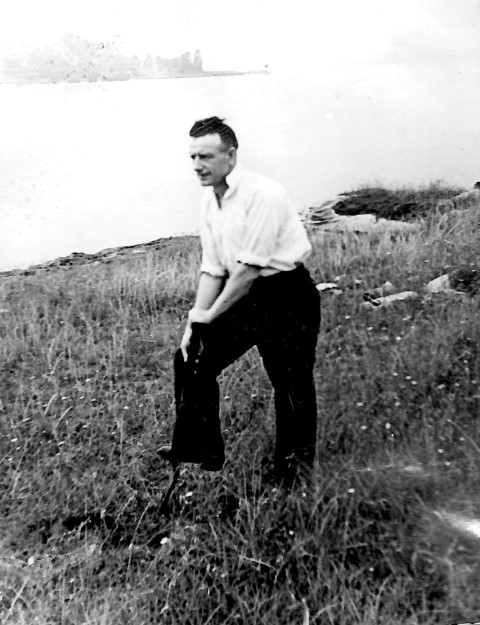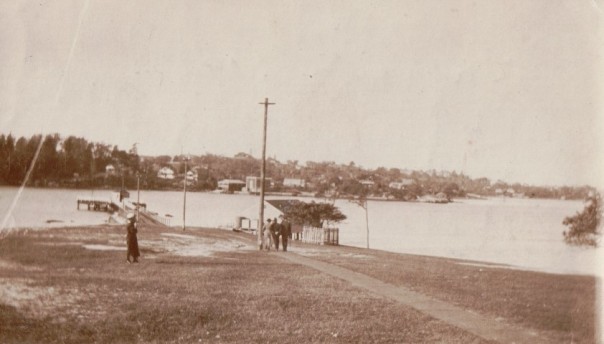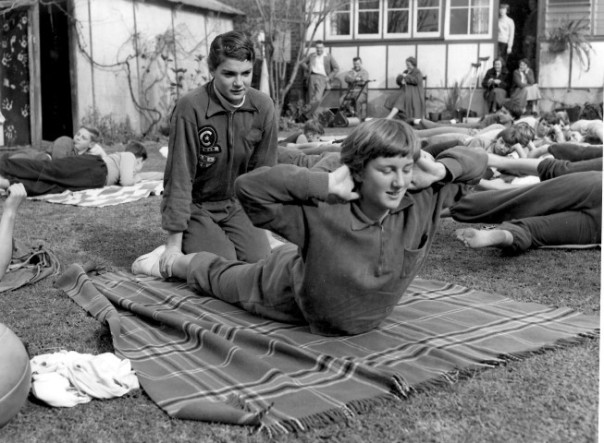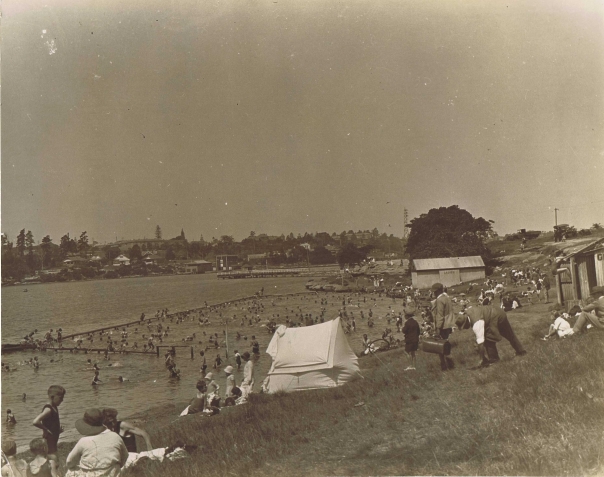Category Archives: Cabarita
Eighty years of swimming
Posted by Local Studies, City of Canada Bay
In the early 1920s Concord Council provided a netted area along the Parramatta River at the northern end of Cabarita Park for swimmers. It’s popularity prompted Council to embark on an ambitious project to build a swimming pool for the community during the Depression years of the 1930s.
Plans were drawn up by Alderman John Dalzell Wallace, a key supporter of the project, and Council’s engineer. Alderman Wallace turned the sod to begin the construction of the pool in March 1937 (shown below). With a grant of £1000 for the purchase of tools and materials from the State Government, work on the pool progressed quickly to make it ready by the following summer.
On 27 November 1937 the Concord-Cabarita Coronation Baths were officially opened by The Hon. H. P. Fitzsimons MLA (Minister for Health). Some 3000 people turned up on the day the pool was opened. To mark the opening there was a 200 yard race between several top swimmers. The race was won by Olympian Moss Christie.
On the following day, a Sunday, 2000 people paid to swim in the new baths. Adults were charged three pence while children could enter for one penny. Within a month over 30,000 people had tried out Concord’s latest attraction.
Now known as the Cabarita Swimming Centre, eighty years on the pool still plays an important part in the lives of local people.
Posted in Cabarita
Tags: Cabarita, Cabarita Baths, City of Canada Bay, Concord-Cabarita Coronation Baths, swimming
A delight to the eye
Posted by Local Studies, City of Canada Bay
The establishment of Correy’s Pleasure Gardens in the 1880s made Cabarita a special picnic destination for Sydney-siders in the nineteenth century.
In 1891 the Australian Town and Country Journal extolled the delights of Cabarita:
‘This beautiful spot is a favourite picnic ground for the residents of Sydney, who are justly proud of the magnificent scenery that is to be found in the vicinity of their city.
The journey to Parramatta by rail is an agreeable one, affording ample variety of scenery to amuse the traveller, but the trip up the river by steamer forms one of the most delightful water excursions that any city can boast of. As the steamer proceeds on its way some pretty suburbs are touched at. Passing Drummoyne and Hunter’s Hill the green covered banks on either side disclose to the visitor a constant succession of beautiful scenes, and the windings of the river as they are followed bring into view at every turn some new charm to delight the eye. A little way beyond Gladesville, but on the opposite bank, Cabarita Point, the spot depicted in our illustration, is situated.
At intervals on the river’s banks, pretty boathouses and rustic-looking piers help to give variety to the scene, while the river is dotted here and there with rowing enthusiasts in their out riggers and light skiffs, and graceful sailing yachts slowly gliding over the smooth waters.’
Posted in Cabarita
Tags: Cabarita, Canada bay Connections, City of Canada Bay, Correy's Pleasure Gardens
Illuminating local stories
Posted by Local Studies, City of Canada Bay
An exciting new art installation planned for Cabarita Park will bring together stories and images of what the park means to local people.
Artists Sean Bacon and Kym Vercoe are collecting stories and images which will be projected on to fig and palm trees in the park. They are having a filming day in Cabarita Park on Saturday, 5 November 2016 from 11am to 2pm so come along and share what the park means to you.
The aerial photograph, taken in 1968, shows Cabarita Park in the centre of the image. In the foreground can be seen the AGL (Australian Gas Light Company) works at Mortlake, now redeveloped as Breakfast Point.
Golden era of swimming recalled
Posted by Local Studies, City of Canada Bay
The 1950s are often regarded as the golden era of Australian swimming.
Recently the National Film and Sound Archive received a donation of rare film footage of swimmers at the British Empire and Commonwealth Games at Vancouver in 1954. It includes local swimmers Lorraine Crapp (now Lorraine Thurlow) and Jon Henricks.
The local Concord community contributed to a fund to send swimmers Jon Hendricks and Lorraine Crapp and oarsman David Anderson to the Vancouver Games. Lorraine Crapp, who was just 15 years old at the time, won the 110-yard and 440-yard gold medals at Vancouver. Upon their return from the Games there was a special civic reception for the three athletes at Concord Council Chambers (at that time situated on Burwood Road, Concord). The photograph shows Lorraine Crapp, wearing the official Games uniform, with David Anderson following. The girls acting as a guard of honour are swimmers from the Cabarita Ladies’ Amateur Swimming Club of which Lorraine was a member. More images of the civic reception can be seen on flickr.
All three athletes went on to participate in the 1956 Olympic Games in Melbourne with both Lorraine Crapp and Jon Henricks winning gold medals.
Cabarita Park
Posted by Local Studies, City of Canada Bay
Cabarita Park has continued to evolve over a period of some 135 years since it was dedicated as a ‘Reserve for Public Recreation and Access to Wharf’ in 1880.
In the early days it was an important vantage point for rowing races held on the Parramatta River which was promoted by the extension of the tram service to Cabarita in 1907. Over the years extensive plantings of trees and gardens together with facilities such as the Federation Pavilion and Concord-Cabarita Coronation Baths combined to make Cabarita Park an important recreational area.
The process of change and development continues with ‘The Conservatory’, an exceptional arts and cultural facility which will be completed next year.
The photograph, above, which shows Cabarita Park in 1923 was recently donated to Canada Bay Connections.
Posted in Cabarita
Tags: Cabarita, Cabarita Park, Canada bay Connections, City of Canada Bay
Local club made a big splash
Posted by Local Studies, City of Canada Bay
In the early 1950s the Cabarita Ladies’ Amateur Swimming Club had a big impact on Australian women’s swimming.
The club was founded by Lesley Thicknesse who had been a diver at the Empire (now Commonwealth) Games in London in 1934. Her three daughters Janet, Val and Pam along with Lorraine and Thelma Crapp were among the first members of the club. Based at Cabarita Baths (now Cabarita Swimming Centre), six members of the club were part of the Australian team at the 1956 Olympic Games in Melbourne.
In view of the regimens of today’s elite swimmers, it’s interesting to reflect on training 1950s style. Winter calisthenics classes were held on the backyard lawn of the Thicknesse family home. Participants were reminded to ‘bring a rug or small blanket’. However, training was under the guidance of Frank Guthrie, one of the great coaches of the period, who helped Lorraine Crapp achieve enormous success in the pool.
The photograph shows Pat Huntingford and Lorraine Crapp participating in a Cabarita Ladies’ Amateur Swimming Club calisthenics class in 1955.
City of Canada Bay is hosting a family fun day at Bayview Park, Concord on Saturday, 21 March 2015, 12noon – 4pm as part of the Parramatta River Catchment Group – Our Living River initiative, to make the Parramatta swimmable again. Come along, it’s free!
Historical postcards released
Posted by Local Studies, City of Canada Bay
Four historical postcards have been released by City of Canada Bay Library Service which show aspects of recreation and work along the Parramatta River.
The earliest image, above, shows the women and men, mixed pairs skiff race near Drummoyne in 1906. Other images show the Lysaght Bros. Co. wharf at Abbotsford Bay, the opening of the Concord-Cabarita Coronation Baths and Rhodes Punt.
The postcards promote the library’s digital image collection, ‘Canada Bay Connections’ and City of Canada Bay Museum. They are available free of charge from Concord Library, Five Dock Library and City of Canada Bay Museum.
Posted in Cabarita, Canada Bay, Chiswick, Drummoyne, Rhodes
Tags: Cabarita, Canada bay Connections, City of Canada Bay, Drummoyne, Parramatta River, postcards, Rhodes
Correy’s Pleasure Gardens
Posted by Local Studies, City of Canada Bay
Music, dancing and picnics have always been enjoyed at Cabarita Park.
From the 1880s until World War 1, a focus of the park was Correy’s Pleasure Gardens operated on land adjacent to Cabarita Park. The pleasure ground was established by Thomas Obed Correy, who had previously owned gardens at Botany in the 1870s. Correy brought plants, flowers, shrubs and trees to Cabarita and provided swings, merry-go-rounds, a cricket field, a running track, summer houses, and from 1887, a dance pavilion, which was a great attraction for the many social and sporting clubs that held their annual picnics at the grounds.
The dance pavilion could accommodate up to 900 people who would be entertained by a ten piece string orchestra. Daytime dances were popular until gas replaced the kerosene lamps and evening dinners and dances became increasingly popular making the pleasure gardens one of Sydney’s leading recreational resorts.
During the World War I, Correy’s Pleasure Gardens declined in popularity and was eventually sold in 1918.
Correy’s Pleasure Gardens are one of many stories of Cabarita highlighted in a new Breakfast Point and Cabarita Park education kit now available on the City of Canada Bay web page. For more images of Correy’s Gardens see our flickr set.
The view from above
Posted by Local Studies, City of Canada Bay
Canada Bay Connections includes many aerial photographs which provide a fascinating perspective of our area.
The photograph above shows the Parramatta River looking towards Cabarita and Mortlake. The huge gas storage tanks of the Australian Gas Light Company (AGL) can be seen dominating the landscape.
AGL purchased 32 hectares of land at Mortlake in 1884 and commenced gas production two years later. Following the closure of the gasworks in 1990 the site has been redeveloped for medium-density housing and today is known as Breakfast Point.
The photograph is by Milton Kent (1888-1965) who specialised in oblique aerial photography over Sydney in the 1930s. The image is believed to have been taken in 1939.
Making a splash
Posted by Local Studies, City of Canada Bay
Cabarita has long been a recreational spot for residents.
In 1923, council provided a shark netted swimming pool at the northern end of Cabarita Park. This was superseded when the Concord-Cabarita Coronation Baths were opened on the 27 November, 1937. In the first month of its operation some 30,000 people made use of the facilities with adults paying three pence and children a penny. It has, of course, since been refurbished and improved to meet the present needs of the community and today is known as the Cabarita Swimming Centre.
City of Canada Bay Museum currently has a display ‘Cabarita, then and now’ which highlights the way the area has changed over the years. The display includes photographs recently donated by Kay Dawson that were taken by her grandfather. The photograph above shows the original pool in 1923.
Posted in Cabarita
Tags: Cabarita, Canada bay Connections, City of Canada Bay, Parramatta River, swimming, swimming pools










